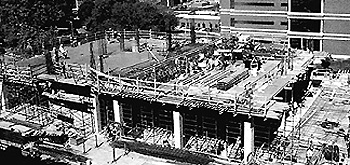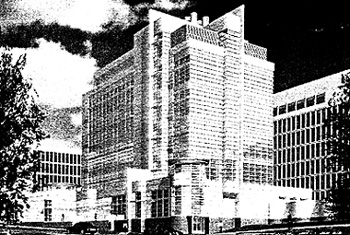

| T H E N I H C A T A L Y S T | M A Y – J U N E 1999 |
|
|
|
VACCINE RESEARCH CENTER RISINGAS NEW DIRECTOR TAKES STOCK |
by Doug Loftus |
 |
|
The
Vaccine Research Center:
In the throes of development in the spring of 1999 (above) and as it is
projected to appear in splendid completion in the summer of 2000 (below).
|
 |
Since construction of the new Vaccine Research Center (VRC) began last year, people working in Buildings 36 and 37 have been front row spectators to a large-scale creative endeavor. Amid noise and a seemingly chaotic array of equipment, cables, concrete, and steel, specialized teams of craftsmen methodically coordinate their activities, progressively building from the foundation upward. When finished, the product of their efforts will benefit not only the research community, but, it is hoped, public health as well. The creation of the VRC itself serves as a fitting metaphor for the planned activities of its future occupants, according to the vision set forth by VRC Director Gary Nabel at the Office of AIDS Research Advisory Council (OARAC) meeting held April 28–29.
Nabel, who has been a Hughes Investigator at the University of Michigan, Ann Arbor, as well as director of the Center for Gene Therapy there, has a strong and diverse background in research and medicine, though vaccine development has not been the focus of his career. "I do actually think there is an advantage to the fact that I wasn’t in traditional vaccine development—I understand the issues, but I think I can come in with more of an open mind and try to facilitate things based on my background," he says.
The background he speaks of includes innovative work on molecular biological strategies and their application to gene-based therapies and vaccinations for AIDS, cancer, and Ebola virus.
He was drawn to the VRC position by the "enormity and challenge of the problem–the unrelenting spread of AIDS and the daunting task of developing a vaccine"—a mission that blended the bench and bedside aspirations of his scientific pursuits. He also realized that rather than remainingstrictly focused on gene therapy, but "using many of the same approaches, applying much of the background I’ve acquired toward HIV vaccine development, I could potentially make a much greater impact." The NIH leadership and the intellectual and material resources available in the strong intramural programs of basic immunology, virology, and structural biology proved a powerful lure as well, he says.
The VRC mission—ultimately the creation of a candidate HIV vaccine (or vaccines)—actually is twofold, according to Nabel. He believes that the advancement of basic science in virology and immunology will necessarily generate clinical gains. As he puts it, "It’s an opportunity to do good science and do some good. It’s not one or the other—it’s both." As he broadly outlined the planned endeavors of the VRC to OARAC members, it became apparent that the Center will occupy a rather unique niche on the NIH campus.
The VRC’s functions will include both research and development directed toward a very specific goal, prompting one Advisory Council member to ask whether NIH will be hosting a medical "Manhattan project" of sorts. Although Nabel doesn’t view it that way, he acknowledges that the VRC will be organized in a manner unlike most institutes and laboratories on campus (athough such efforts are not without precedent at NIH; see "Vaccine Pursuit Accelerated in NIAID Malaria Research Program," The NIH Catalyst, March–April 1999).
Nabel anticipates about 100 full-time slots, with perhaps 15 senior and junior investigators, and an additional 50 postdocs. Personnel will function in three major areas: basic research, a core analytical and production (including GLP) facility, and clinical and regulatory affairs. He expects that VRC operations in these areas will greatly benefit from strong partnerships with intramural and extramural scientists, with private biotech and pharmaceutical companies, and with the FDA as well. The challenge of creating an effective HIV vaccine, Nabel believes, demands idea sharing across the public and private sectors.
Once the Center is staffed, the goal is to apply all available resources to bring candidates to Phase I trials on campus. At the immunological level, this means producing vaccines with the capacity to elicit effective antibody and cytotoxic T lymphocyte responses. Nabel anticipates that much information can be gained testing formulations among HIV seropositive individuals but that, ultimately, a truly protective vaccine—vs. one designed for therapy—is a more realistic goal.
On the subject of realism,
Nabel is asked how he views President Clinton’s challenge to develop an
HIV vaccine within 10 years. He says he sees it as a "useful benchmark,"
a reasonable period of time in which to determine "whether it can be done
or not and to figure out where to go from there." ![]()